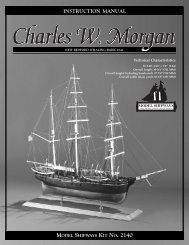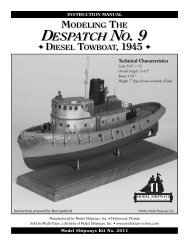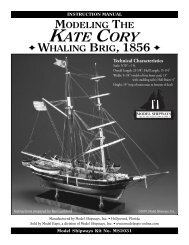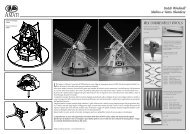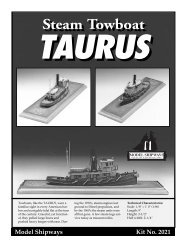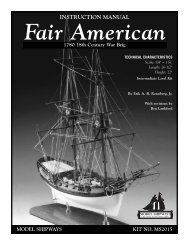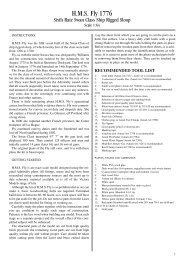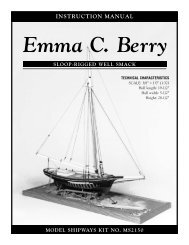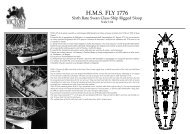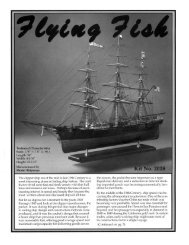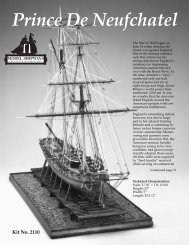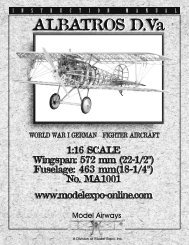download benjamin latham instruction manual
download benjamin latham instruction manual
download benjamin latham instruction manual
Create successful ePaper yourself
Turn your PDF publications into a flip-book with our unique Google optimized e-Paper software.
A plank length approximately 6 inches will cover four bulkhead<br />
spaces. This is a comfortable length to handle for this<br />
model. To scale, it is a plank 24 feet long. However, to avoid<br />
having very short pieces at the bow and stern, you may need<br />
to use a longer plank to complete the run.<br />
To follow real ship rules, you should stagger the butts on the<br />
model (see figure 15). The sketch shows a stagger sequence<br />
which is similar to that of real ships. The stagger also applies to<br />
the deck planking. The 6-inch plank works well with the rules.<br />
With this length you can meet the rule for three full plank<br />
widths between butts on a single frame. Had you used a plank<br />
length to cover only three bulkhead spacings, this would not<br />
be possible. Because the butts occur on bulkheads, you would<br />
wind up with only two full planks between the butts.<br />
4. Spiling<br />
On real ships, more so than on models, edge bending is limited.<br />
The wood may be very stiff, so each plank must be cut to<br />
shape. Spiling is the term used for laying out the cuts (see figure<br />
16). It’s simply a matter of transferring curves to a straight<br />
plank, then sawing the plank to shape. For the Benjamin W.<br />
Latham model, the wide planks landing at the sternpost should<br />
be the only strakes you need to spile. For narrow planks, the<br />
basswood strips are flexible enough so they can be edge bent<br />
into place.<br />
5. Fastening the Planks<br />
There are some fancy plank clamps on the market, but they are<br />
more trouble than they are worth. They must be screwed into<br />
the edge of the bulkheads, leaving a big hole to contend with<br />
when doing the next plank. Instead, you can hold the shorter<br />
planks in place, or position them with straight pins. Be careful<br />
not to split the plank when using straight pins. If necessary,<br />
drill a small pilot hole first. Glue each plank to the bulkheads,<br />
and edge glue them together. For the edges, use white or carpenter’s<br />
glue so that setting will not occur too fast. At the bulkheads,<br />
it is good to use thin super glue to quickly secure the<br />
plank in place.<br />
While glue alone will hold the planks, you may wish to use<br />
small brass brads or wooden treenails for additional holding<br />
power, or just for looks. Using fine brass brads, cut off and discard<br />
the heads, then hammer them into place. If treenails are<br />
desired, you can buy them commercially. Better yet, get some<br />
long bamboo skewer sticks, strip off small pieces, then pull<br />
them through a draw plate until you have very small dowels.<br />
Drill holes for the treenails, add a touch of glue and drive them<br />
into place. Treenails are good if you want to add them for each<br />
frame. While there are no frames, only bulkheads, use the bulwark<br />
stanchions for locating where the frames would be.<br />
6. Planking the Outer Hull<br />
Belt Layout: Now the fun begins! From the Hull Planking Layout<br />
drawing, use a tick strip along each bulkhead location and<br />
mark the belt seams. Using a tick strip, transfer the location of<br />
the belt seams onto each bulkhead and mark them with a pencil.<br />
Next, lay the battens (1/16” x 1/8” x model-length basswood<br />
strips) along the marks and temporarily tack them in<br />
place.<br />
The purpose of the battens is to assure an accurate flow of the<br />
belts. Even though the Hull Planking Layout was developed to<br />
provide an accurate flow of belts, errors in drafting and tick<br />
strip marking may occur. The battens were designed to assist<br />
in this regard. With them in place, any errors previously made<br />
can be corrected. Also, you may not like the flow and desire to<br />
change it to suit your own taste.<br />
FIG. 18 – Sloping the Plank Edges<br />
Severe slope–<br />
some rounding of<br />
plank required<br />
BOW AREA<br />
Planksheer<br />
Edge must<br />
be sloped<br />
and fitted<br />
STERN AT TRANSOM<br />
With all the battens in place, visually check their flow. Look at<br />
the model from the side and from the bow and stern. Do the<br />
battens have nice smooth curves Adjust them if necessary (see<br />
figure 17). The sketch shows what they should look like from<br />
the side. When everything seems okay, remark the belt seam<br />
lines on the bulkheads, making sure they are clearly indicated.<br />
You do not want to lose them. You may now remove the battens.<br />
It would be a good idea to leave the middle batten in<br />
place temporarily to help secure the hull so it won’t warp before<br />
it is planked.<br />
Sloping Plank Edges: As you proceed with the planking, you<br />
may need to slope the edges of a particular plank so it butts<br />
flush against the adjacent plank. This is especially true for a<br />
plank adjacent to another member intersecting at an angle. For<br />
example, the first plank below the planksheer at the bow<br />
should butt against the planksheer at an angle. At the stern, the<br />
angle is even more severe. The edges of these planks must be<br />
trimmed so they fit against the planksheer (see figure 18).<br />
To begin with, all the planks on the hull have square edges.<br />
When butted against each other on a round hull form, a small<br />
gap will appear between each plank. Most of the gaps eventually<br />
will be filled with glue, or you may fill them with wood<br />
filler. On a real ship, the gaps are caulked. In fact, the edges of<br />
the planks are often sloped to increase gapping. This measure<br />
assures that the inside of the planks butt against each other,<br />
while on the outside there are sufficient gaps for caulking. If<br />
you want a perfectly smooth hull without the gapping, you<br />
must trim the edge of each plank as you fit it. It’s a lot of work<br />
but your decision.<br />
Laying the Planks in Belt A: Each belt of planking should be<br />
done separately. Consequently, you can start with any belt. For<br />
discussion, let’s start at the top and work down. Belt A has six<br />
planking strakes below the planksheer forward of the deck<br />
step. Aft of the deck step, there is a seventh strake. The extra<br />
strake fills the space caused by the deck step which raises the<br />
planksheer on the quarter deck. The maximum plank width is<br />
at Bulkheads G and H. The planks here should taper both forward<br />
and aft. All the planks can be cut from 1/4” x 1/16”<br />
strips. They should be slightly over 3/16” wide amidships,<br />
tapering to about 1/8” at the bow and 3/32” at the stern. Full<br />
size, the maximum width is about 10 inches.<br />
Use a tick strip and lift the plank widths from the Hull Planking<br />
Layout. If you have changed the locations of the battens,<br />
first mark the position of the seventh aft plank below the<br />
planksheer and in line with the forward planksheer. Then, simply<br />
divide the remaining space into six equal plank widths at<br />
each bulkhead. A set of proportional dividers would help.<br />
Mark these lines on the bulkheads with a pencil. You should<br />
now have a completely marked area for Belt A.<br />
15



